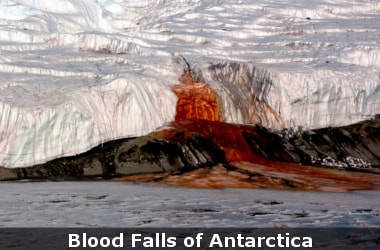
Geologists have finally uncovered the truth behind the seemingly mysterious ‘Blood Falls’ of Antarctica.
Located in the McMurdo Dry Valleys, the falls were discovered by researchers in 1911 when it poured off the cliff in the Great Taylor glacier.
The bright red colour of the water was attributed to discolouration caused by red algae.
But now, research is proposing a new solution.
According to the research, the red colour is a product of oxidisation of iron that takes place when iron minerals dissolve in high-density salt water or brine.
When this water comes in contact with oxygen, a process of oxidation ensues which imparts the bright red colour. (This is also the same process by which iron rusts when exposed to air.)
The research team used imaging from underneath the glacier using a technique called radio-echo sounding or RES.
This is important because saline water indicates variation in densities that were ultimately used to uncover the process of oxidation.
It was found that the brine, which was from a lake that flows underneath the Great Taylor glacier, takes 1.5 million years before finally reaching the Blood Falls.
The brine is discovered to have picked up minerals from underlying hard bedrocks and gushes forth off the surface of the glacier through fissures.
Water containing soluble impurities such as salt freezes at a much lower temperature than fresh water.
The frozen water contains a certain amount of latent heat that can keep the river flowing.
This means that while the surface may remain frozen, the underlying brine remains liquid. (It is the same principle based on which people salt streets during the winter before the onset of a storm.)
The brine remains liquid within the subglacial and englacial environments through latent heat of freezing coupled with elevated salt content.
The findings suggest that cold glaciers could support freshwater hydrologic systems through localized warming by latent heat alone.
Finally, the pressure of the solid block of ice above forces water through an intricate channel of fissures which culminate in a red river that falls off Great Taylor.
Another interesting insight is the presence of microbial organisms that inhabit these saline rivers with low oxygen content and survive eons in isolation. It can serve as evidence for adaptation in harsh environments.